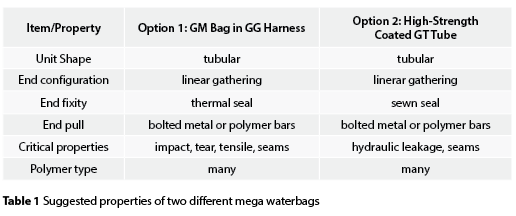
According to the United Nations (UN), 1.1 billion people in 34 countries have inadequate access to safe drinking water. Furthermore, pollution, global warming and population growth will have continuing negative impacts on the availability of safe drinking water. By the year 2040, the UN estimates that more than 2 billion people in 60 countries will not have an adequate supply of clean water.
When these statistics are coupled with data from UN Environment (UN-EP) that 50% of the world’s population lives within 37 miles (60 km) of an ocean and three-quarters of all large cities are located on coasts, it seems reasonable that a potable water source transported by huge waterbags in the ocean to such water-short areas should be implemented. As an example, Robert M. Koerner’s Terzaghi Lecture, presented in 1996, illustrated that a mega waterbag for a six-month water supply to the city of San Diego, California, would be 600 × 150 × 18 meters in size.
The realization of the above concept came about via a contract between the Nordic Water Supply ASA and the Turkish government in 1997 to transport potable water from the mainland to the island of Cypress. Relatively small bags with a one-month capacity (10,800 m3) were alternatively utilized for the next few years (see Figure 1). The system they developed are called REFRESH waterbags.
In light of the enormous size of such bags, and the harsh and difficult stresses on the containment bag, Weggel and Koerner (2007) suggested that conventional bags (as used routinely in the geomembrane industry) could be contained with geogrid-based harnesses, which would be used for water transport in trains. It would also be used to provide individual anchorage at filling and emptying stations. Hoop and longitudinal stresses of the harness system are presented, as well as fixity methods at the filling and emptying ends of the journey. This type of bag support system, however, has not been used to my knowledge.
A different potential advantage to the Spragg concept of using coupled (and smaller) bags in a train is the use of a coated, high-strength fabric for the enclosure. Such high-strength fabrics as used in soil-filled geosynthetic tube technology (Koerner 2012) are readily waterproofed and have the advantage of being gathered at both ends. This in turn provides for articulating mechanical connections, so as to provide the coupled trains
during the ocean-towing process. To me, this seems more straightforward than zipping continuous sections.
The point of this column is to make readers aware of this exciting technology and one which can potentially be further advanced using concepts and materials that are conventionally used in the geosynthetics industry. These two proposed new variations using geosynthetic materials are the following:
Traditional geomembrane (GM) bags within geogrid (GG) harnesses
Coated (i.e., impermeabilized) high-strength geotextile (GT) bags, like enormous waterproofed geotextile tubes
The following table outlines our current ideas.
Anderson, T. L., and Landry, C. J. (2001). “Exporting water to the world,” Jour. Contemporary Water Research and Education, 118: 60–67.
Euronews. (2016a). “Bags of water.” <http://www.euronews.com/2012/12/06/bags-of-water>
Euronews. (2016b). “The big bag theory: A cheap and innovative way to transport fresh water.” <http://www.euronews.com/2016/01/25/the-big-bag-theory-a-cheap-and-innovative-way-to-transport-fresh-water>
Koerner, R. M. (2012). Designing with geosynthetics, 6th ed., Xlibris Publishing, Indianapolis, Ind.
Koerner, R. M. (1996). “Emerging and future development of selected geosynthetic applications,” the 32nd Terzaghi Lecture, ASCE National Conference, Washington, D.C.
Tulip, R. (2008). “Spragg Bag water transport and storage technology for climate adaptation,” Spragg and Associates submission to Garnaut Climate Review. <http://www.kysq.org/docs/Spragg.pdf>
Weggel, J. R., and Koerner, R. M. (2007). “Floating (geogrid supported) geomembrane megabags for Emergency Water Supply,” Proc., GRI-20 Conf., Geosynthetic Institute Publication, Folsom, Pa., Paper #13.
 TEXTILES.ORG
TEXTILES.ORG




Former Alaska governor Wally Hickel had this idea back in the 80’s. Alaskan water was to be shipped in giant bags to California. While an interesting idea it ignored the reality of the millions of lakes between Alaska and California as possible sources to be piped.